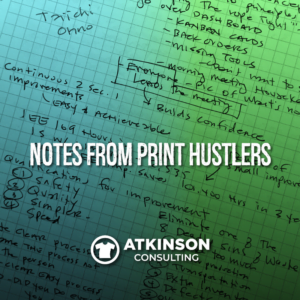Shops in the decorated apparel industry have had an established challenge with managing money. You absolutely need it to survive. Cash is always king. Without it, you can’t pay your staff, your bills, and most of all, yourself as profit.
Duh.
Yet, we give away a lot of financial power by routinely going into debt at the request of our customers. That’s right. When you invoice at Net30 or go the 50% upfront route, or any other payment method…you are essentially the bank for your customer.
You take on all the work. Create the art, order the shirts. get it set up, and run the order. Even ship it!
All with the hope that the customer will pay up. Most do.
But some don’t. There are even some client types that are the absolute worst at paying you. (I’m looking at you school districts and startup apparel brands)
It’s sometimes even worse than that.
You may even have orders sitting in your customer pick area from a few weeks or even months. Those customers ordered stuff and never claimed it.
I’ll bet they didn’t pay for it completely either.
Rethink How You Structure Your Payments
Hopefully, this article is a shove in a better direction.
It’s simple. When someone places an order, before you do anything, they pay 100% of the bill.
100%.
Imagine how easily your business could run if it had all of the financial fuel in the tank on a constant basis?
Remember this. A customer that doesn’t pay you isn’t really a good customer. When you have to fight tooth and nail for every dollar it makes the struggle to stay in business all that much harder.
When money sits in the bank before you do anything?
That seems almost dreamlike, doesn’t it?
But Marshall, Our Customers Won’t Stand For That
Are you sure?
Mega-giant Custom Ink doesn’t have a problem with this. Their sales are tops in our industry at over $300 million dollars in 2018. They are 100% upfront on payments.
Amazon, who everyone in any industry is absolutely terrified of, runs the same way. 100% upfront on payments. $232 billion dollars in sales for 2018.
Yeah, that’s great. But you aren’t Custom Ink or Amazon.
I know.
But I’ll bet they employ some pretty smart people. Sometime, somewhere, one of those geniuses declared that all orders needed to be cash upfront. No purchase orders. Don’t take Net30. We aren’t going to do 50% down, 50% when it ships.
They drew a line in the sand and stuck to it.
The Breakdown
Here’s why cash in the bank matters to your business more than anything:
It’s all about timing.
Money in the bank is the lifeblood of your business. You can have hundreds of orders in your system, but without the cash on hand to produce them your shop may be financially-starving while you are waiting for the money to come in. Are you experiencing that stress right now?
On paper, your shop P&L may even look great.
Except when you start paying out to the groups with their hands out. Debt repayment, equipment payments, inventory purchases, consumable purchases, employee salaries, and expenses, plus taxes to the government.
All of that is flowing out on a constant basis.
While you are squeaking by, staring forlornly at the mailbox for checks, or bank account statements for electronic payments. I’ve talked to plenty of shop owners with over six figures of outstanding money owed to them past thirty days. Some are almost numb to it. “Meh, it’s what you gotta do.”
The struggle is real.
Why Not Change?
So, what are you waiting for? Why not make the change to 100% upfront for payments?
Sure, I’ll admit it might be scary. Change is difficult.
However, let me tell you about my friend and coaching client Bobby. A few months ago he attended one of our Shirt Lab events. At that event, he met another friend and coaching client, Darryl.
Bobby runs a contract decorator shop in Texas, and Darryl runs a direct to consumer shop in California. Even though they both screenprint shirts, they have completely different business models.
During a few of the networking slots at Shirt Lab Darryl told Bobby the merits of going 100% upfront on payments. That’s how he runs his shop, and he’s seen tremendous financial stability because of that platform. This has allowed him to scale and be more financially independent than ever before.
Driving home from Shirt Lab on Sunday that’s all Bobby could think about. On Monday morning, he changed his policy. He had his graphic designer create some signs to place on the wall. In his system, he changed some language on the invoices.
It’s been about three months since that Shirt Lab, and I talked to Bobby a few days ago about the switch and the reaction from his customers. Here’s what he told me:
“It’s going great. I only had two customers really complain about it. It is surprising the traction it has had with my customers. What’s great is that everybody has adopted it, and it hasn’t been a big deal at all. In fact, because I’m a contract printer, even some of my clients have told me that they wish they could go that route too. It’s amazing.”
You Can Do It Too
100% upfront payment isn’t an isolated thing with only Bobby and Darryl. Tons of shops do this. Just check out any Facebook group, and you will see many people in those groups talking about it.
If you are interested in changing to this policy here are a few things to think about:
- Talk to your financial team or accountant. What would this change mean to the company? Imagine the impact it would have if your Accounts Receivable amount was continually zero?
- You can’t go halfway. It’s going to be confusing to your customers and your staff on who is exempt. Just make the switch and go. Don’t look back.
- For existing customers that are sending orders in, let them know what’s going on and give them some space to adjust. Bobby told me he sent out notices and let each customer have one order “the old way” before they were required to switch. But after a cutoff date, every order that came in was the new 100% upfront on payment.”
- Post a sign on the wall and have language in any customer-facing notice about the requirement. Remember, if it isn’t written it doesn’t exist.
- Train your staff. You need them to not only get involved but be a part of the process. Have them help.
- Talk to a few key customers. Let them know about the expected change and have them review your materials for their opinions. “Hey, what do you think about this?” Get their feedback.
- Some customers might take exception. Have a plan to deal with this. Instead of a Purchase Order, have them place their order with a credit card. That company, school district, organization, or group probably buy from Amazon too. Discuss your change and have them understand what you are doing. Ask them, “Do you make purchases with a credit card?”
Financial stability is what we are after here.
Remember, it doesn’t matter how great your business model is, how wonderful your website works, how many orders are in the system, or how profitable you are.
You can’t survive if you can’t manage your companies cash.
As my Uncle Bill has always famously said, “Money greases the skids of life.” Who can argue with that?
Get paid!
“Number one, cash is king. Number two, communicate. Number three buy or bury the competition.” – Jack Welch
“I’m a cash flow guy. If it doesn’t make me money today, forget about it.” – Robert Kiyosaki
“I think for any small business that’s bootstrapped, the overwhelming challenge initially is getting to positive cash flow.” – John Mackay
Let’s Talk Profit

Are you as profitable as you need to be? Many shops are extremely busy, but at the end of the year, there just doesn’t seem to be as much money for the owner’s distribution as planned.
Why is that?
For starters, it could be with how your pricing system is set up. Learn how to do it right with my best-selling eBook – “Price for Profit”. This easy to follow eBook can help you build pricing matrices that work, as they don’t rely on the “average of all the shops around me method”…but instead, a combination of your shop’s costs and production efficiency.
That’s right. Imagine using your own shop’s math to build out your pricing. Do it the right way with the help of “Price for Profit”. For $59, it will be the best investment you make today!






2 comments
Keith Burwell
https://uploads.disquscdn.com/images/9ca37323827ac68f75b2702ed74136268c9f6549b2a5a61078f8f48358e2144c.jpg Hey Marshall here is the signs we posted first thing this morning after attending Shirt Lab over the weekend. Had two customers come in and not even question it. Thanks!
Marshall Atkinson
Keith – Fantastic! The power of learning and action combined! Love it. Thanks for sharing! -M